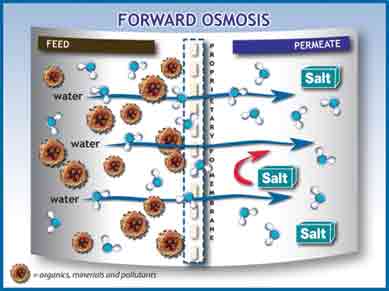What is Forward Osmosis ?
 The natural process of osmosis has been observed for centuries. The first documented observation of osmosis was in 1748 by Jean-Antoine Nollet. The word “osmosis” was coined by Rene Joachim Henri Dutrochet and in 1867, Moritz Traube perfected the art of osmosis by inventing selective precipitation membranes. This invention also created a technique of measuring the osmotic flow.
The natural process of osmosis has been observed for centuries. The first documented observation of osmosis was in 1748 by Jean-Antoine Nollet. The word “osmosis” was coined by Rene Joachim Henri Dutrochet and in 1867, Moritz Traube perfected the art of osmosis by inventing selective precipitation membranes. This invention also created a technique of measuring the osmotic flow.
Forward osmosis is also automatically occurring and requires no additional hydraulic energy like reverse osmosis. But in this process, the draw solution is controlled for a specific amount and quality of concentration. Control over the draw solution ensures that unwanted dissolved solutes are avoided by water trading into the draw solution. This process has gained popularity in the last few years due to its list of advantages over reverse osmosis.
Some of the applications of Forward Osmosis include:
- Pre-treatment of difficult wastewater
- Retention of desirable compounds
- Used in desalination for low membrane fouling
- Used in Evaporative Cooling Towers
- Used with RO for Cannabis wastewater treatment
- Minimal liquid discharge applications.
What Is Forward Osmosis - FO Process?
Forward Osmosis is an osmotic process that effects the separation of water from dissolved solutes with a semi-permeable membrane. In contrast with reverse osmosis, FO occurs rather naturally by using a draw solution with predetermined concentration. It is maintained to have more concentration than the feed solution resulting in an automatic osmosis process. Due to this, the FO process is more energy-saving than RO. Because of the predetermined concentration, FO is also known as Engineered or Manipulated Osmosis in the industry.
Understanding Forward Osmosis (FO) Water Purification Systems
FO water treatment systems use the process to separate water molecules from dissolved solutes in the feed solution. Experts at AMPAC USA conducted the most extensive and comprehensive research on the subject to get in-depth knowledge of how to create an energy-efficient FO product. After years of research, the company launched its FO products that are advanced in technology and produce the required results.
FO process purification systems can be manufactured to suit residential, commercial and industrial purposes. In seawater desalination, FO along with distillation can produce fresh drinking water without all the challenges of the RO tech. This technology is known to cause low fouling that has been a major problem with RO membranes since they were first used. AMPAC USA FO products are able to achieve low fouling, provide required water permeate at the touch of a button.
Our products are especially known to be helpful in cannabis wastewater treatment when used with RO and in the commercial line of brewing coffee and beer. The unique technology allows brewers to retain taste, flavor, color and aroma of certain elements they need. The skilled workers at AMPAC can now custom design an FO water treatment product that suits your needs.
How Forward Osmosis Works:
In Forward Osmosis, the driving force is the draw solution which is more concentrated than the feed solution. The net flow of water molecules from the feed solution through the semi-permeable membrane to the draw solution is induced by the concentration. This semi-permeable membrane is very selective to water molecules. In contrast, RO requires external pressure to pass water molecules from the feed solution to the other side as the concentration is high and thus uses more energy than FO.
In FO processes, solute diffusion is possible in both the directions and majorly depends on the individual compositions of the feed and draw solutions. This means the draw solutes may diffuse to the feed solution and vice versa. For any particular FO process therefore, the required permeate water and concentration of the feed solution plays a very important role in designing the concentrate of the draw solution.
The membrane between the two solutions simply results in the trade of solutes between them. As mentioned above, depending on the concentration of the feed and the intended purpose of the FO process, trade is all that may be required from this process. The Membrane Technology at AMPAC USA enables higher rejections using proteins in the active layer which are virtually 100% selective to just water molecules, which drastically lowers back the diffusion of draw solutes.
Forward Osmosis In Conjunction With Reverse Osmosis
Forward Osmosis can be used in combination with RO for better water permeate results. After FO, the draw solution contains dissolved salts with water molecules. When we put this process through RO, pure drinking water is produced instantly. FO essentially may not be able to remove all the dissolved chemicals, metals, microorganisms and so on. For this, treatment with RO is more than enough, it removes almost 100% of the remaining contaminants. Combining the two processes has a lot of advantages.
- FO acts as a pre-treatment process that protects the RO membrane from getting worn out due to exposure to suspended particles.
- RO process is more energy-efficient as the number of dissolved solutes is lesser than in feed water only for RO
- The FO draw solution can be repeatedly be used after the RO process making the whole system sustainable.
This combination is applied in treating wastewater from cannabis cultivation centers for whom, the wastewater discharge guidelines are stringent.

